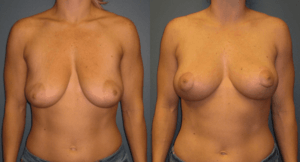April 16, 2018 | 3 minute read
 While sagging breasts are a fact of life for many women, it is not something you have to settle for. Many factors can lead to breast sagging (ptosis), including pregnancy, weight loss, and aging. However, a breast lift (mastopexy) can give you a more youthful appearance by raising your breasts to a higher position on your chest. Dr. Conrad utilizes multiple techniques when performing breast lift surgery; the specific technique used for your procedure will be determined during your consultation. The technique used can depend on such factors as the severity of your ptosis, your desired result, and the anatomy of your breast.
While sagging breasts are a fact of life for many women, it is not something you have to settle for. Many factors can lead to breast sagging (ptosis), including pregnancy, weight loss, and aging. However, a breast lift (mastopexy) can give you a more youthful appearance by raising your breasts to a higher position on your chest. Dr. Conrad utilizes multiple techniques when performing breast lift surgery; the specific technique used for your procedure will be determined during your consultation. The technique used can depend on such factors as the severity of your ptosis, your desired result, and the anatomy of your breast.
Grades of Breast Ptosis
There are three grades of breast ptosis, and the specific grade affects the technique that Dr. Conrad will use during your procedure. During your consultation, he will examine your breast and the degree of sagging you are experiencing. He will use this information to determine which technique would be most effective for meeting your treatment goals.
Grade 1: Mild
If the nipple falls to the bottom crease of the breast (also called the inframammary fold), then you have mild ptosis.
Grade 2: Mild to Moderate
This ptosis is characterized by the nipple falling 1 to 3 centimeters below the inframammary fold.
Grade 3: Severe
This is indicated when the nipple falls more than 3 centimeters below the fold.
Procedure Options
During your consultation with Dr. Conrad, he will discuss which of the following techniques is most suitable to your specific goals.
For small breasts and/or minor ptosis:
- Partial Lift: Gives a slight lift to the breast, making it most suitable for those women with mild ptosis. Dr. Conrad will make an incision above the areola and shift the areola upward. He will also adjust the skin and tissue to enhance the shape of the breast.
- Benelli Lift: Also known as a donut lift, Dr. Conrad makes an incision around the areola, removing any excess skin from this location. The nipple is also moved higher up on the breast.
For larger breasts and moderate to severe ptosis:
- Lollipop Lift: This is similar to the Benelli Lift (with the incision around the areola), but Dr. Conrad will also make an incision down the midline of the breast to the inframammary fold. This causes the incision to resemble a lollipop. The larger incision with this technique allows for greater adjustment of skin and tissue.
- Anchor Technique: This is also known as the inverted-T. It is similar to the lollipop lift in that the incision resembles a lollipop, but it also includes an incision along the inframammary fold. These incisions resemble an anchor, and it gives Dr. Conrad the greatest access to shape the breast tissue. Additionally, it is most suitable for larger breasts with an excess amount of sagging.
To discuss your options for breast lift surgery with Dr. Conrad, contact our office for a consultation. We can be reached at 316-681-2227.

